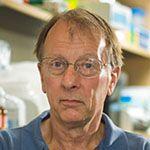We are currently focused on a pair of CNS-specific bHLH transcription factors known as Olig1 and Olig2. The two Olig genes map to within 40 kb of each other on human chromosome 21 within the Down syndrome critical region. During embryonic development and also in the postnatal brain, the two Olig genes are expressed in progenitor cells that give rise to oligodendrocytes and certain types of neurons (notably motor neurons). Beyond merely marking these cell types, targeted disruption of Olig1/2 in developing embryos disrupts patterning of the ventral spinal cord, ablates formation of oligodendrocytes throughout the CNS and prevents formation of motor neurons. The two Olig proteins are similar to each other within the DNA-targeting bHLH motif. Outside the bHLH domain however, Olig1 and Olig2 are very different proteins and this is reflected in non-overlapping biological functions. Olig1 function has been shown to be essential for the repair of demyelinating lesions in murine models of multiple sclerosis. Olig2 is expressed in the stem-like cells that are found in high-grade human gliomas and is essential for tumor formation in “genetically relevant” murine models of human glioma. Current activities in the Stiles lab are aimed at defining 1) structural features of the two Olig proteins that underlie their separate biological functions, 2) genetic targets of Olig genes and 3) key co-regulator proteins. A variety of methods are used towards these ends including mass spectroscopy, ChIP/Seq and high throughput RNAi screens.
"The two Olig genes map to within 40 kb of each other on human chromosome 21 within the Down syndrome critical region. During embryonic development and also in the postnatal brain, the two Olig genes are expressed in progenitor cells that give rise to oligodendrocytes and certain types of neurons (notably motor neurons)."
Cold Spring Harb Symp Quant Biol
View full abstract on Pubmed
Soc Gen Physiol Ser
View full abstract on Pubmed
Biochim Biophys Acta
View full abstract on Pubmed
J Cell Physiol
View full abstract on Pubmed
Blood
View full abstract on Pubmed
Proc Natl Acad Sci U S A
View full abstract on Pubmed
